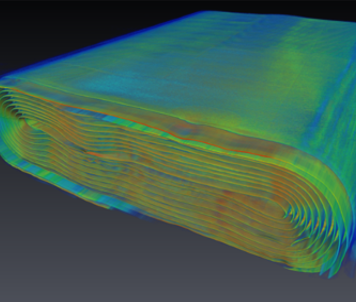Energy Materials

Synchrotron techniques provide a way to observe changes in material properties such as oxidation state or crystalline phase. They also allow the non-destructive, in-situ analysis of complex electrochemical reactions in operating devices. Many synchrotron techniques are element specific, which is especially important for targeted analysis of alloy-based electrode materials.
Catalysts

Catalysis is a well-established application of synchrotron spectroscopy and x-ray diffraction/total scattering, where experiments can be carried out in-situ or in-operando to monitor changes in phases, metal chemistry and reaction intermediates. Synchrotron-based spectroscopy is uniquely suited for the chemical analysis of catalytic systems. Many techniques are surface sensitive and element specific, allowing targeted analysis of complex catalytic reactions. Diffraction and total scattering techniques yield information about the short, medium and long range structure of the catalyst material. These techniques provide direct information on important catalytic properties like oxidation state, crystalline phases, particles size and coordination chemistry.
Engineering Materials

Uncovering the complex physical and chemical interactions between the components of composite materials is a unique advantage of synchrotron-based techniques. Synchrotron-based X-ray imaging has proven extremely useful for imaging the microstructure of composite materials like carbon fiber, alloys, fiberglass and laminar structures. It is also much faster than conventional techniques, allowing in-situ imaging of defects, damage, stress and manufacturing processes like resin curing.
Electronic Materials

The current electronics industry is largely based on silicon but scientists from around the world have been using synchrotron-based tools to explore the novel functions of next generation electronic materials. Advanced technologies allow scientists to design and fabricate new materials at atomic level and to explore the exotic properties that can only exist in thin films or interfaces.
In-situ Hub
The Energy Materials In-situ Hub (EMIH) is a collection of multiple instruments that can be used for dynamic experiments, electrochemical cycling and preparation of samples on site so that users can carry out relevant experiments at CLS, rather than rely on their own labs in the home institution.
In addition to the beamlines where most of energy-materials research is carried out (HXMA, SXRMB, SM, SGM, VLS-PGM, BXDS, BMIT), the collection of instruments in the hub includes:
- In-situ electrochemical cells for the Scanning Transmission X-ray Microscope at the SM beamline
- Electrochemical cycling station portable to multiple beamlines for dynamic experiments of charging and discharging batteries in realistic conditions
- Electrochemical and gas in-situ cells for hard and tender X-ray beamlines (HXMA, SXRMB)
- Liquid cells for SGM, HXMA, SXRMB beamlines
- Two glove boxes for battery materials (each one dedicated to different chemistries so as to avoid contamination)
- Temperature controllers
Visit the EMIH to find a full list of specific infrastructure available at the CLS:
In-situ HubRecent News
Loading...
Access
Purchased Access
Purchased access offers quick and accurate solutions to proprietary questions. CLS scientists develop experimental plans based on clients' needs, collect and analyze data, and provide detailed reports with key answers to critical questions.
Peer-Reviewed Access
Academic clients can submit proposals through a peer review process. Beam time is granted based on scientific merit, with the expectation that any results will be published. In special cases, rapid access is also available for instrument or beam time.
